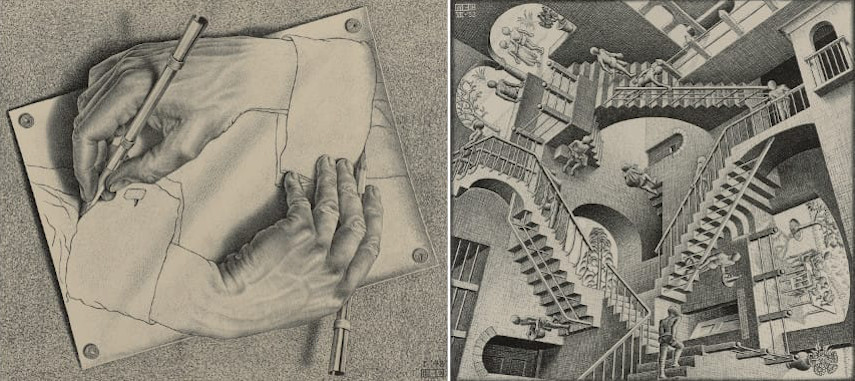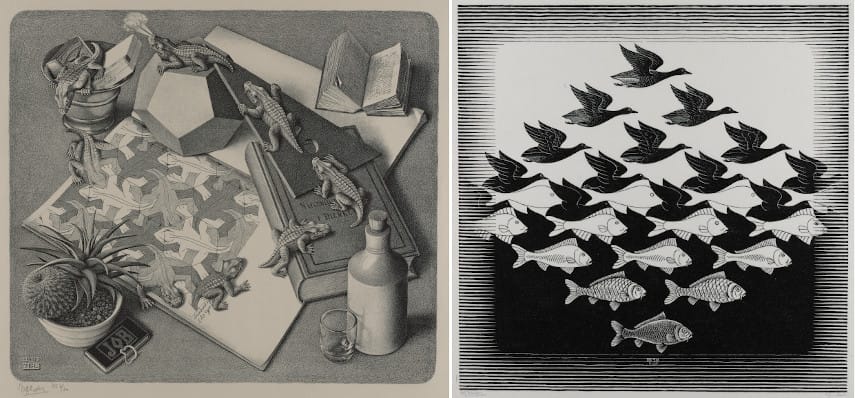MFAH Opens the Most Comprehensive Survey of M.C. Escher Ever
Most of the iconic 20th century artworks have been produced within a specific movement. However, there is a myriad of artists whose innovative practices were hard to categorize for many reasons, one of them being Maurits Cornelis Escher.
This pioneering figure is inscribed in art history as a one-man art movement informed by science, especially mathematics. His entire activity is inseparable from nature; the way he examined insects, landscapes, and plants to include them in his compositions saturated with architectural elements has been fully authentic as no other artist has created such powerful signature imagery. Apparently, far ahead of its time, Escher’s works gained special prominence during the psychedelic era of the 1960s and 1970s.
Five decades later, this artist is finally getting his due. The current retrospective at the MFAH is the largest and most comprehensive exhibition of works by M.C. Escher ever held. It encompasses over 300 works on paper and more than 100 of the artist’s constructed objects, carved woodblocks, and working tools from the collection of Michael S. Sachs, the great collector who acquired ninety percent of the Escher estate in 1980.

The Optical Illusions After Escher
Throughout his career, M.C. Escher evolved from the artist interested in realistic observations of the world to the skillful and scientifically triggered explorer of the relationships between art and science and logic and irrationality. MFAH’s curator of Prints and Drawings, Dena M. Woodall, underlined that this exhibition, spanning the artist's entire career, "explores Escher’s detailed thought process."
It reveals, in a way, the magic behind the final prints, with the inclusion of preparatory drawings and progressive printing proofs as evidence of his working process. His meticulous manner extends to printing all of his woodcuts by hand with the back of a spoon, instead of a press.
The exhibition is organized chronologically and thematically so that a full range of his development could be understood, especially the preoccupations such as Platonic solids metamorphoses, tessellations, the transformation of two-dimensions into three-dimensions, reflecting worlds, spirals in space, impossible buildings, and approaches to infinity.
Among the highlights, the visitors can see the works Sky and Water I (1938) and Reptiles (1943), which encapsulate Escher’s metamorphosis and the evolving space. Also on display, In Hand with Reflecting Sphere (1935) and Magic Mirror (1946), these works illustrate the artist’s interest in the effect of the globe and mirror reflections. Part of the exhibition is also the never-ending cycle Metamorphosis III (1939–68), which is Escher’s largest print consisting of 31 woodblocks.

M.C. Escher at The MFAH
The current survey celebrates the artist whose work resists categorization and who was neglected in the art world for a really long time. Furthermore, it highlights Escher’s genuineness in terms of developing an authentic vocabulary that makes him an iconic art figure of the 20th century.
The exhibition Virtual Realities: The Art of M.C. Escher will be on view at the Museum of Fine Arts in Houston until September 5th, 2022.
Featured image: M.C. Escher - Bond of Union, April 1956, lithograph, Courtesy of Michael S. Sachs. All M.C. Escher works © The M.C. Escher Company, The Netherlands. All rights reserved.
Can We Help?
Have a question or a technical issue? Want to learn more about our services to art dealers? Let us know and you'll hear from us within the next 24 hours.
